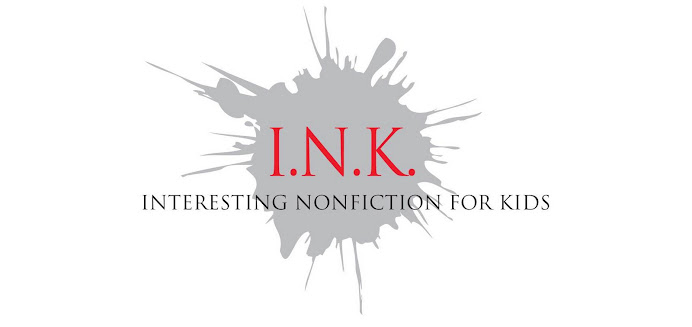Here are some recommendations for other excellent children's nonfiction. Tis the season to buy nonfiction!
From Marfe Ferguson Delano:

Fabulous Fishes, written and illustrated by Susan Stockdale. (2008, Peachtree Press, $15.95 hardcover) This charming picture book features simple rhyming text ("Shiny fish / spiny fish/ fish that hitch a ride") and bold, colorful pictures that introduce kids to all sorts of fishes. A spread at the back of the book gives more information about the fish included in the book.

Listen to the Wind: The Story of Dr. Greg & Three Cups of Tea, by Greg Mortenson and Susan L. Roth, illustrated by Susan L. Roth. (2009, Dial Books for Young Readers, $16.99) I enjoyed Mortenson's Three Cups of Tea, but I love the way Susan Roth retells this true story through the eyes of the Pakistani children. Her stunning paper-and-fabric collages take my breath away.
From Gretchen Woelfle:

Bad News for Outlaws: The Remarkable Life of Bass Reeves, Deputy U.S. Marshal sports the longest title and the most stunning cover I’ve seen this season. Gregory Christie’s monochromatic close-up headshot of Reeves is riveting. Christie continues with atmospheric endpapers and many full-page paintings which fit this monumental subject. Vaunda Micheaux Nelson’s colloquial text is also a perfect fit for a man who lived a most dramatic life. Slave, runaway slave, sharpshooter, and wily master of disguise, he became the first African American U.S. Deputy Marshal and served for thirty-two years. Nelson recounts several wily nonviolent captures by Reeves who brought more than 3000 outlaws, including his own son, to justice. The only quibble I have with this exciting story is the opening scene. Though Reeves killed only fourteen men out of 3000, Nelson opens with a thrilling but deadly confrontation with one of the fourteen victims. As an old peacenik, I would have preferred to see him outsmart rather than outshoot his man in the opening pages.
From Rosalyn Schanzer:

I first began my extensive collection of children’s books when I was a young illustrator and well before I began to write books on my own, so I used to select each book based solely upon the quality of the illustrations. One of my favorite early choices was the nonfiction book Ashanti to Zulu: African Traditions. This Caldecott Award Winner was first published in 1975, and the artwork looks every bit as good today as it did way back then. Written by Margaret Musgrove and stunningly illustrated by the indefatigable husband-and-wife duo, Leo and Diane Dillon, it’s a classic alphabet book that intrigues its readers by introducing them to 26 exotic African tribes. The Dillon’s elegant layouts and their gorgeous, richly colored, and well researched portrayals of the African people taught me how pivotal the illustrations in a book can be. As it turns out, the writing is charming too.

My second nonfiction choice is Tibet: Through the Red Box by Peter Sis. In this 1998 Caldecott Honor Book, Sis finds a mysterious red box, and upon opening the lid with a rusty little key, he discovers the diary his filmmaker father had written when he was lost in Tibet years before. Once again, it’s the magically symbolic artwork that draws readers into this exotic tale, sweeping readers back an forth in time on each otherworldly spread. The pictures I’ve included here are a pale shadow of the glorious ones in the book, so I invite you to have a real-world look for yourself.
David Elliott's poetry reduces familiar animals to their essence and makes us think in On the Farm, illustrated beautifully by Holly Meade's woodcuts.
Barry Denenberg's Lincoln Shot: A President's Life Remembered--what a great idea. I wish I had it!
From Anna Lewis:
Fantastic NF books to inspire creativity this holiday season:Touch the Art: Catch Picasso's Rooster (Board book)By Julie Appel (Author), Amy Guglielmo (Author)Sterling November 2009Best book yet in the series. Includes my fav, Franz Marc!365 Things to Draw and Paint (Art Ideas)By Fiona WattUsborne Publishing Ltd October 2009.
This book would have kept me busy the entire Winter Break. Full of ideas to inspire hours of drawing fun because kids always moan, "But, I don't knowwhat to draw."What's the Big Idea?: Inventions that Changed Life on Earth ForeverMaple Tree Press November 2009Helaine Becker (Author), Steve Attoe (Illustrator)New, fun book that shows kids that their ideas can change the world.
Fun NF books to combine with building sets:LINCOLN LOGS Building Manual: Graphic Instructions for 37 World-FamousDesigns Sterling December 2007TINKERTOY Building Manual: Graphic Instructions for 37 World-Famous DesignsSterling December 2007Dylan Dawson (Author) Robert Steimle (Illustrator)




















